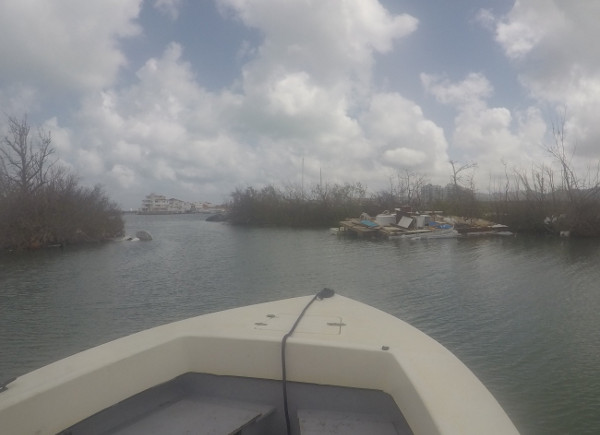 On the 6th of September powerful category five storm, Hurricane Irma struck Sint Maarten with 185 MPH winds, causing widespread damage to the island and its infrastructure.
On the 6th of September powerful category five storm, Hurricane Irma struck Sint Maarten with 185 MPH winds, causing widespread damage to the island and its infrastructure.
The storm also caused significant damage to the island’s nature and environment prompting the Sint Maarten Nature Foundation to conduct rapid qualitative assessments to determine the level of impact. The first Terrestrial and Marine Assessments were carried out from the 12th to the 16th of the second assessment was conducted from the 22nd to the 25th of September and will continue for some time.
Terrestrial Impacts:
Solid Waste
It is also expected that solid waste disposal due to infrastructure challenges and cleanup will have a significant impact on the community. The Philipsburg landfill was already over capacity before the storm and collected storm debris will contribute to the challenges regarding solid waste significantly.
The Nature Foundation is concerned regarding the management of the significant amount of solid waste and the disposal as such. The Nature Foundation is also concerned about pests, including rodents and insects (flies and mosquitos primarily) impacting the community.
Hurricane Irma caused significant damage to the island’s flora. The majority of large trees, some with historical and cultural significance, have been toppled. Most foliage on the island has been burnt by wind and salt spray. Most hills, valleys and other green areas were completely defoliated leaving the island brown and leafless.
However, due to rains brought by Hurricane Maria and subsequent rainfall on the 24th and 25th of September, there is progress with regards to the recovery of flora, with some areas having significant greenery return.
Avifauna (birds) have also been hard hit by Irma’s significant winds. Although some species are showing signs of recovery, other species have been particularly hard hit. Rookery sites being monitored by the Nature Foundation of the Brown Pelican, Sint Maarten’s National Bird, have been decimated and recovery will take some time. Since the passing of the Hurricane Irma, some breeding pairs were observed in the Little Bay area but the pelican population has suffered significantly.
Because of a shortage of available food, the Nature Foundation is requesting the population to place bird feeders in their gardens. A glass or bottle with a simple mix of sugar and water will suffice.
Marine Impacts
The following impacts regarding the Marine and Wetland Ecosystems were recorded:
The Simpson Bay Lagoon can be considered an environmental disaster, with thousands of gallons of vessel fuel still being leaked into the environment.
Mullet Pond Ramsar Site
An estimated 90% of mature mangroves have been destroyed. The area of Mullet Pond, a Ramsar Wetland of International Importance, has suffered particularly significant damage. Mangroves strands were also uprooted because sailboats tied unto mangrove roots illegally causing significant damage. Most of these vessels have now sunk.
Since the last assessments, most vessels have cleared out of the Mullet Pond area and the Nature Foundation has started with the clean-up of the site. A number of vessels will have to be salvaged in the area and will take significant effort to complete.
Other Wetlands
Significant debris is still being recorded in all wetlands and coastal areas from various sources, from the previously estimated 120 sunken vessels of differing size in the last assessment that number has risen to above 200. Vessel sizes range from 100 meters to five meters. Because of the large amount of sunken vessels very large quantities of fuel have been spilled in especially the Simpson Bay Lagoon and Oyster Pond wetlands. Estimated fuel spilled in the Simpson Bay Lagoon exceeds 200,000 gallons and is still being leaked. The Nature Foundation has contacted the authorities regarding this but to date, little assistance has been provided. The Nature Foundation is concerned that the lasting impacts of the fuel spill will have on the environment and public health of Sint Maarten.
There has been very little support for clean-up activities from an environmental perspective. In order for successful mangrove restoration activities to commence the water-quality issue in the Simpson Bay Lagoon has to be addressed.
The water quality of all wetlands and beaches is still questionable given the fuel-leakage issues and run-off from land. The Nature Foundation will continue to assess water-quality in order to determine the increase of afore-mentioned.
During previous assessments in Simpson Bay and in the Simpson Bay Lagoon large areas of seagrass beds have been uprooted and decimated. During subsequent surveys, it was estimated that the island has lost, thus far, two hectares of native seagrass beds.
Man of War Shoal Marine Protected Area (National Marine Park)
The Marine Park has suffered significant damage. Although in-depth assessments have not yet been made, rapid qualitative assessments have established that there has been significant storm damage to the Marine Park. An estimated 50% of coral colonies observed have suffered extensive damage and there is significant siltation still in the Marine Park. The Marine Park has only been in existence for six years and the resiliency of the area to recover from this significant weather event remains to be seen.
Coral reefs contribute more than USD 50 million annually in ecosystem goods and services to the economy of Sint Maarten. Due to the impacts of the hurricane, Irma Sint Maarten will see a significant reduction in the goods and services provided by the ecosystem.
The Nature Foundation Coral Nursery Project structures, acoustic hydrophone transmitter arrays, conch and seagrass experiments and scuba dive moorings are still non-existent due to the passage of the storm. In the coming weeks, the Nature Foundation will move towards re-installing critical dive moorings at locations where research projects were being conducted.
Beaches
Beaches have experienced significant erosion due to the storm surge brought on by Hurricane Irma and there has been a significant impact on Sea Turtle nesting habitat. The 2017 Sea Turtle Nesting Season Monitoring Program has been canceled. Most beaches are still significantly covered by debris both on land and submerged. The Nature Foundation will continue to dive beaches in order to determine and submerged hazardous obstacles.
Advisories
The Nature Foundation would like to issue various advisories to the public:
- Still do not eat fish, alive or dead, from surrounding waters. Due to run-off seafood may be contaminated and not safe to eat.
- Be careful when using beaches. The Nature Foundation has not had the opportunity yet to survey all beaches for debris and there may be sharp, dangerous objects in the water that can cause injury.
- Please follow instructions from Government to not burn garbage. Burning garbage is illegal and can release toxic chemicals into the air.
Nature Foundation Press Release










